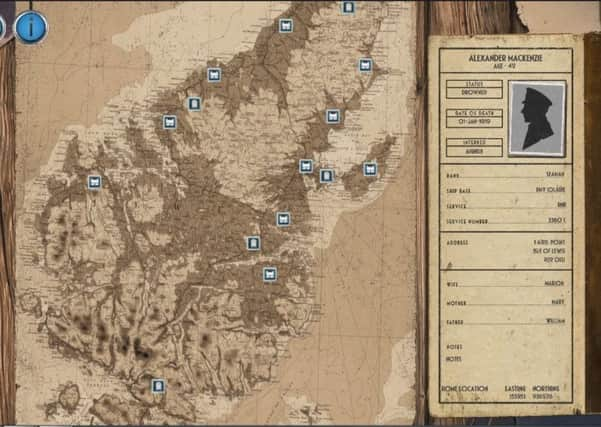Untold stories of Iolaire disaster mapped in an interactive visualisation


HMY Iolaire was returning sailors to the Western Isles from fighting in World War 1 when it foundered on rocks and sank on New Year’s Day 1919.
The final death toll was 205, of whom 181 were from the islands, devastating the communities on both Lewis and Harris.
Advertisement
Hide AdAdvertisement
Hide AdTo mark the 100th anniversary of this tragedy, researchers from Abertay University in Dundee and the University of the Highlands and Islands have developed an online application, Visualising the Iolaire, which provides a virtual map of the disaster.
It details those that died, identifies the communities directly and indirectly impacted, while also documenting how people have been memorialised on the island.
The development of the online application has been led by Dr Iain Donald from the School of Design and Informatics, at Abertay University, Europe’s top ranked University for computer games education.
He said: “The original aim of the project was to look at how the impact of a single event can transform a community.
Advertisement
Hide AdAdvertisement
Hide Ad“Previously we have looked at how the 4th Black Watch casualties at the Battle of Loos in 1915 had impacted the city of Dundee.
“The story of the Iolaire is especially poignant as it occurred after the war was over and was bringing sailors home to be with friends and family for New Year in 1919.
“Working with Dr Iain Robertson at the University of the Highlands and Islands and the community partners on this project has demonstrated what a heavy price the Western Isles paid during the war, and the Iolaire tragedy was sorrow heaped upon sorrow.”
The research behind the project was led by Dr Iain Robertson from the Centre for History at the University of the Highlands and Islands.
Advertisement
Hide AdAdvertisement
Hide AdHe said: “At a time when society is once more having to work out how to recover from a collective trauma, it is important to see what lessons can be learnt from history.
“We have collected memories of silence, of the ‘widow’s share’, and of the joy felt when sisters and cousins, returning from working in Dundee, were no longer dressed in mourning black.
“And we have heard a song sung by the son of the bard who, upon returning from the war himself and hearing that two of the island’s sons had been lost, felt moved to compose his personal tribute and commemoration of the disaster.”
The project is funded by the Arts and Humanities Research Council’s ‘Living Legacies 1914-18’ WW1 engagement centre, which has been helping to fund community led research projects to mark the centenary of the First World War.
Advertisement
Hide AdAdvertisement
Hide AdIt is a collaboration between Abertay University and the University of the Highlands and Islands, in partnership with the Kinloch Historical Society, Sandwick Community Council and Museum nan Eilean (Heritage Service of Comhairle nan Eilean Siar).
The online application can be viewed: HERE